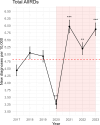Rising incidence of systemic autoimmune inflammatory rheumatic diseases during the COVID-19 pandemic: a geographical cohort study
- PMID: 40514058
- PMCID: PMC12164633
- DOI: 10.1136/rmdopen-2024-005227
Rising incidence of systemic autoimmune inflammatory rheumatic diseases during the COVID-19 pandemic: a geographical cohort study
Abstract
Objective: The natural infection with SARS-CoV-2, or vaccination against it, has been postulated to directly contribute to an increase in the incidence of autoimmune inflammatory rheumatic diseases (AIIRDs). Conversely, preventive measures limiting access to healthcare services could have resulted in missed or delayed AIIRD diagnoses or have reduced the infection rate of any triggering infections. We aimed to define real-life trends in AIIRD diagnoses from the prepandemic period through 2023 in a large and geographically circumscribed population of 6.5 million inhabitants.
Methods: AIIRDs' annual diagnosis rates from 2017 to 2023 were derived from the registration of disease-specific exemption codes of the resident population of Lazio, a highly populated region in central Italy. Incidence rate ratios (IRRs) were calculated to compare pandemic and average prepandemic rates (2017-2019). Poisson regression was used to define statistically significant changes.
Results: A total of 16 254 AIIRD diagnoses were registered over the 7-year period. The average prepandemic incidence of AIIRDs was 4.81 per 10 000 inhabitants (95% CI 4.69 to 4.92). Compared with the prepandemic period, the diagnosis rate decreased in 2020 (IRR 0.68, 95% CI 0.64 to 0.72) but remained above prepandemic levels in 2021, 2022 and 2023. In 2023, there was a 22% increase in AIIRD incidence compared with prepandemic levels (IRR 1.22, 95% CI 1.17 to 1.28, p<0.001). This excess incidence was primarily driven by increases in both primary arthritides and systemic rheumatic diseases.
Conclusions: We observed a temporary decline in diagnosis in 2020, followed by a substantial increase from 2021 to 2023. This trend (decline and increase) may be linked to COVID-19 infection or to the reduction and subsequently potential increase of other infectious triggers following the use of preventive measures, such as facial masks and social distancing.
Keywords: Arthritis, Psoriatic; Arthritis, Rheumatoid; COVID-19; Epidemiology; Sjogren's Syndrome.
© Author(s) (or their employer(s)) 2025. Re-use permitted under CC BY-NC. No commercial re-use. See rights and permissions. Published by BMJ Group.
Conflict of interest statement
Competing interests: None declared.
Figures


Similar articles
-
COVID-19 and rheumatic autoimmune systemic diseases: report of a large Italian patients series.Clin Rheumatol. 2020 Nov;39(11):3195-3204. doi: 10.1007/s10067-020-05334-7. Epub 2020 Aug 27. Clin Rheumatol. 2020. PMID: 32852623 Free PMC article.
-
Incidence and prevalence of vaccine preventable infections in adult patients with autoimmune inflammatory rheumatic diseases (AIIRD): a systemic literature review informing the 2019 update of the EULAR recommendations for vaccination in adult patients with AIIRD.RMD Open. 2019 Sep 19;5(2):e001041. doi: 10.1136/rmdopen-2019-001041. eCollection 2019. RMD Open. 2019. PMID: 31673420 Free PMC article.
-
SARS-CoV-2 infection in patients with autoimmune rheumatic diseases in northeast Italy: A cross-sectional study on 916 patients.J Autoimmun. 2020 Aug;112:102502. doi: 10.1016/j.jaut.2020.102502. Epub 2020 Jun 8. J Autoimmun. 2020. PMID: 32527675 Free PMC article. Clinical Trial.
-
Increased incidence of rheumatoid arthritis after COVID-19.Autoimmun Rev. 2023 Oct;22(10):103409. doi: 10.1016/j.autrev.2023.103409. Epub 2023 Aug 18. Autoimmun Rev. 2023. PMID: 37597602 Review.
-
COVID-19 Vaccination in Patients with Autoimmune Inflammatory Rheumatic Diseases: Clinical Guidance of the Korean College of Rheumatology.J Korean Med Sci. 2021 Mar 29;36(12):e95. doi: 10.3346/jkms.2021.36.e95. J Korean Med Sci. 2021. PMID: 33783147 Free PMC article. Review.
References
-
- De Lorenzis E, Parente P, Natalello G, et al. Chronic related group classification system as a new public health tool to predict risk and outcome of COVID-19 in patients with systemic rheumatic diseases: A population-based study of more than forty thousand patients. Joint Bone Spine. 2023;90:105497. doi: 10.1016/j.jbspin.2022.105497. - DOI - PMC - PubMed
MeSH terms
LinkOut - more resources
Full Text Sources
Medical
Miscellaneous
